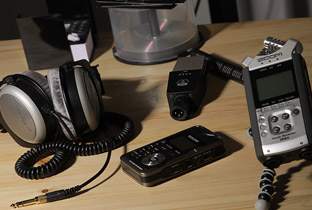Published
Tue, Apr 19, 2011, 16:30
- We look at how field recordings can form the backbone of original music.

This week's column picks up on some ideas from RA's recent interview with Tommy Four Seven. It's an inspiring read and yet, to be honest, it really shouldn't be. Tommy's driven by the idea that while he loves his chosen genre (techno in his case), he's bored of hearing the same drum and synth parts. He has responded by realizing one fundamental musical truth—that at the root of any track is just a collection of sounds and there's no earthly reason why these can't come from just about anywhere.
The dictionary definition of music is "organised sound" and if you're happy to roll with that it doesn't take long before you realize that any sounds can be organised into arranged, musical form. In fact, music has always taken inspiration from the natural world, one example being classical orchestral pieces which emulate birdsong in their melodic lines. Another is the grinding industrial sound of Detroit techno, whose roots were famously a response to the natural rhythms of their urban environment.
If you listen carefully to the world around you and you're in a position to capture it with a field recorder, you'll soon realize that you can substitute the frequency areas required of your mix with natural sounds. For instance, the atmospheric drones and pads so many of us enjoy are easily replaced or enhanced by real-life ambiences such as street noise or, for a calmer environment, perhaps a field of long grass gently swaying in the wind. The weather can also play a vital role in production with heavy downpours or eerie icy winds providing a dark subtext to records which can help push a track's emotional side.
Through processing, it's possible to turn found sounds into brand new ones, whether you take Tommy's approach of thickening sounds with distortion and overdrive or whether you use your own approaches. Filtering and EQs can root out unwanted material and turn even rich sounds into menacing drones or high-pass filtered whines, for instance. I'm drawn to his bravery in bouncing down sound rather than creating effect chains too—one of the thrills of working with audio is to commit to each stage of the process and leave yourself little room for going back on your decisions. Each new layer of bounced sound creates further opportunity for processing, meaning that over four or five passes of bouncing, sounds can so radically change in character that they bear little resemblance to their source recordings.
Why, might you ask, do field recordings and found sounds need to be at the root of such sonic experiments, rather than synth sounds? The answer, of course, is that synth and drum sounds do respond to this approach too but there's a much greater emotional relationship with sounds you've recorded yourself. For starters, you know recorded material is available only to you, which immediately forms a special bond. Plus, there's something truly different about work only ever being constructed in the audio domain; if you're trying to break some habits, what better way to get started than to put your controller keyboard to one side? As well as often forming alliances to certain plug-ins, we tend to allow our playing hands to fall into the same patterns when hovering over keyboards. With these two points in mind, it's no surprise our work starts to sound less diverse once we've struck upon a sound which we're happy to call "ours."